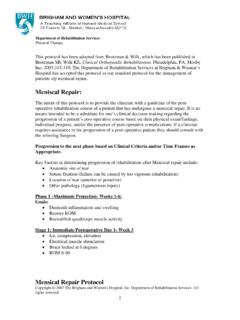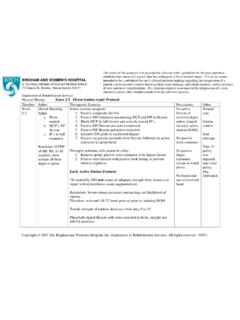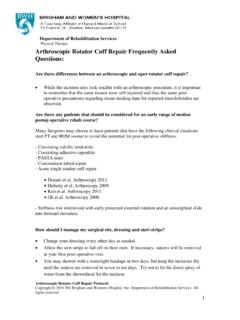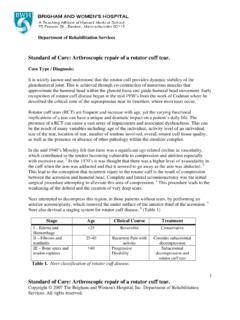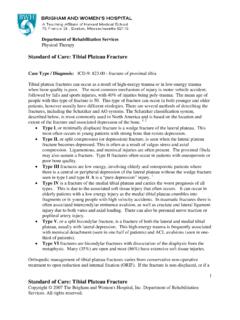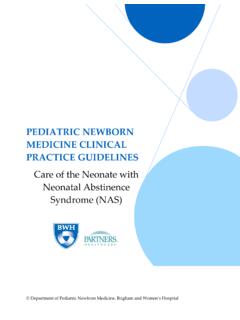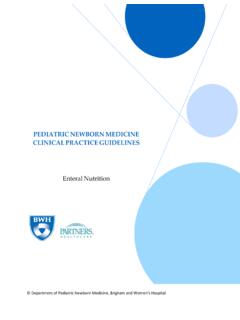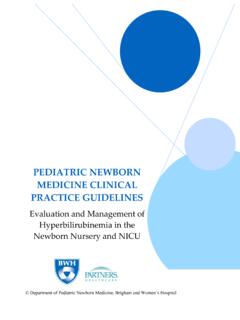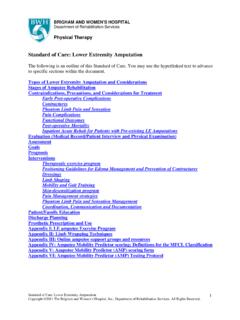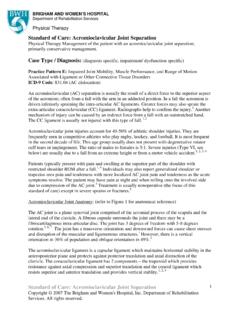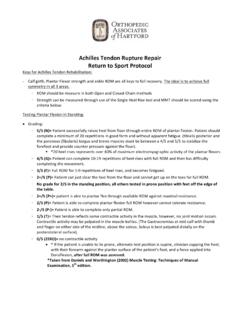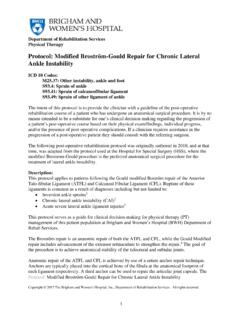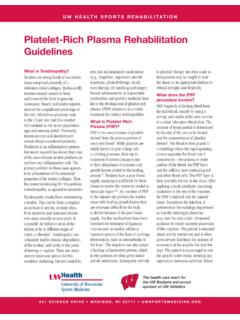Transcription of Departments of Rehabilitation Services and Orthopaedic …
1 Departments of Rehabilitation Services and Orthopaedic Surgery Post-operative Rehabilitation protocol following Arthroscopic Hip Surgery for Femoroacetabular Impingement Arthroscopic Hip Surgery for Femoroacetabular Impingement Copyright 2020 The Brigham and Women's Hospital, Inc., department of Rehabilitation Services . All rights reserved 2 Departments of Rehabilitation Services and Orthopaedic Surgery Post-operative Rehabilitation protocol following Arthroscopic Hip Surgery for Femoroacetabular Impingement Hip preservation surgery has become an increasingly common procedure to address a number of intra-articular hip disorders including labral tears and femoroacetabular impingement.
2 The number of hip arthroscopies has increased greatly in the past decade. With this increase in number of surgeries have come advancements and refinements in surgical techniques and increasingly complex considerations for Rehabilitation needs. Hip arthroscopies with labral repair and FAI correction are typically a successful procedure with improvements in function (mHHS) and pain (VAS) typically seen in patients at 3, 6, and 12 This Rehabilitation protocol has been written with consideration of current surgical techniques and avoidance of post-operative complications. Proper Rehabilitation to avoid post-operative adhesions, and appropriate weight bearing, along with manual therapy to manage post-operative impairments are all important factors to consider in order to minimize the risk of adverse outcomes.
3 The rationale for aspects of this protocol is provided in the following paragraphs to increase clinician knowledge and understanding. Since surgical techniques and procedures can vary for each patient, the clinician should obtain and read the detailed operative report in order to gain a full understanding of what must be considered in the post-operative period. Consideration for tissue quality, bone quality, success of repair , and surgical technique should be assessed and considered by the clinician. Avoidance of irritation and inflammation in the post-operative phase is imperative. In the first phase of Rehabilitation the focus is to protect the repair and avoid irritation. Gluteal isometrics have been shown to be helpful in decreasing iliopsoas spasm and preventing anterior hip pain and are therefore initiated in Phase I of the One surgical technique that merits special consideration in post-operative Rehabilitation is capsular closure.
4 Capsular closure is performed to restore the normal anatomy and minimize the risk of post-operative issues with instability. With the capsular repair closure technique, it is necessary to protect and limit hip external rotation and extension in the early healing phase to protect the integrity of the Capsular integrity has been correlated to improved outcomes after hip arthroscopy with FAI correction. Additionally, the clinician should consider whether the labrum was repaired or reconstructed. If the labral tissue is inadequate the surgeon may reconstruct the labrum using an autograft or allograft. This information can be accessed in the operative note and will impact Rehabilitation . The evidence for manual therapy after hip arthroscopy is developing.
5 It is thought that manual therapy to the musculature and joints around the hip joint helps to decrease nociceptive input and address impairments that develop in the pre and post-operative period, thereby decreasing abnormal forces to the hip joint and improving patient In order to protect the integrity of the labral repair or reconstruction, capsular repair , and protect the fluid seal, long axis hip distraction should not be performed until 8 weeks after labral repair and 12 weeks after labral reconstruction. Joint mobilizations of grade III-IV should not be performed until 8 weeks postoperatively for the aforementioned reasons. Arthroscopic Hip Surgery for Femoroacetabular Impingement Copyright 2020 The Brigham and Women's Hospital, Inc.
6 , department of Rehabilitation Services . All rights reserved 3 Intra-articular adhesions have been recognized as a cause of surgical complications and pain. In an analysis of possible risk factors for adhesions following hip arthroscopy, the following factors were identified: age under 30, Modified Harris Hip score under 50, no microfracture performed, and Rehabilitation without Passive range of motion circumduction is incorporated into treatment to minimize the development of post-operative adhesions. Appropriate progression of weightbearing and gait retraining are essential aspects of Rehabilitation . With respect to weightbearing, the patient is initially limited to 20 lb of foot flat weight bearing in the immediate post-operative phase.
7 This limitation is due to the concern for appropriate healing of the labral repair or reconstruction, and the capsular repair . Foot flat weight bearing is indicated to avoid achilles irritation or shortening, irritation or shortening of hip flexors and stressing the labral repair or Patients should be counseled that they should not self select a non-weightbearing pattern due to increased compressive forces to the hip joint due to hip flexor It is expected that the gluteus medius will be inhibited post-operatively, therefore special attention should be paid to gait retraining and proper crutch use to avoid contralateral hip drop when weightbearing on the operative leg to avoid irritation to hip joint or Patients should be advised to continue with use of assistive device for 6 weeks following surgery.
8 Or until their gait without device is without deviation. Allowing unassisted gait with deviations will cause intraarticular irritation and overuse of accessory muscles around the hip, possibly delaying the healing Clinicians should have a good understanding of the expected progression and healing timeframes as outlined in this protocol . If patient is not progressing appropriately, or if there is concern for post-operative complications, the surgeon should be contacted and notified of the patient s status. Progression to the next phase of Rehabilitation is based on achieving both Clinical Criteria as well as Time Frames. Variance from this needs to be reviewed by surgeon. The intent of this protocol is to provide clinicians with a guideline of the post-operative Rehabilitation for patients following arthroscopic hip surgery for femoroacetabular impingement.
9 This protocol is not intended to mandate the course of patient care. If there are concerns regarding the patient s clinical presentation. Please consult with the referring physician prior to making adjustments to the protocol . Procedures Performed: Acetabuloplasty Labral repair Labral debridement Labral reconstruction Chondroplasty Microfracture Fibrin glue repair Femoroplasty Capsular repair Iliopsoas Release Endoscopic Trochanteric Bursa Excision Endoscopic Abductor repair Arthroscopic Hip Surgery for Femoroacetabular Impingement Copyright 2020 The Brigham and Women's Hospital, Inc., department of Rehabilitation Services . All rights reserved 4 Specific Case Complexity and Limitations: Primary Procedure Revision Procedure Comments: _____ Pace of protocol : ROUTINE LESS-AGGRESSIVE Comments.
10 _____ Weightbearing Timeframe Weightbearing 0-21 days Partial weightbearing 20 lbs, step to pattern, foot flat gait 3-6 weeks Gradually increase weight bearing to WBAT pain-free 6 weeks-8 weeks Gradually wean from crutches, decrease to single crutch, then without device as tolerated Range of Motion Hip Motion ROM Days 0-21 ROM Week 3-6 ROM Week 6-12 ROM Week 12+ Flexion 0-90 degrees Gradually increase in pain free manner Gradually increase in pain free manner Gradually increase in pain free manner Extension 0 degrees, no motion beyond neutral 0-10 degrees Gradually increase to fully ROM as tolerated If full ROM not attained, gradually increase to full ROM Abduction 0-30 degrees 0-45 degrees Gradually increase to full ROM as tolerated If full ROM not attained, gradually increase to full ROM External Rotation 0-30 degrees 0-45 degrees Gradually increase to full ROM as tolerated If full ROM not attained, gradually increase to full ROM Internal Rotation 0-30 degrees 0-45 degrees Gradually increase to full ROM as tolerated Gradually increase to full ROM as tolerated Bracing: none Arthroscopic Hip Surgery for Femoroacetabular Impingement Copyright 2020 The Brigham and Women's Hospital, Inc.
